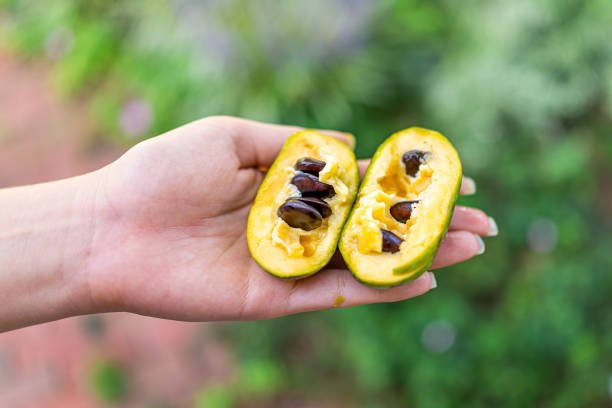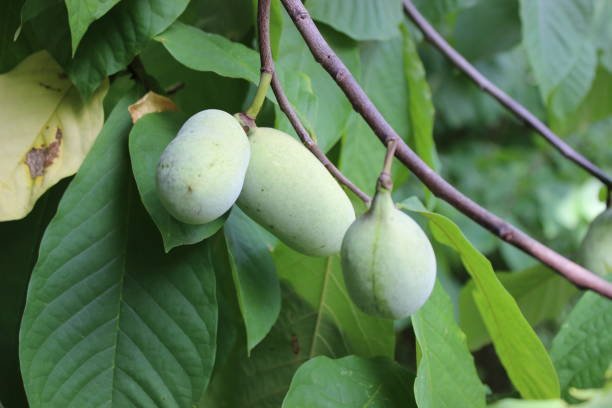Select Pawpaw Seedlings- 0.75' to 1' tall 2 Year Old Plant
Asimina triloba
Pawpaws are beautiful tropical looking native plants that produce exquisite and very nutritious mango-like fruit that can be grown in temperate climates (ranging from Florida to Canada!). They can grow in the shade, but are most productive in full sun (up to 50 pounds of fruit per plant!) and part shade. These plants are seedlings from the coveted ‘Davis’ Pawpaws. You will need two genetically distinct trees to produce fruit
Where to Plant:
In full sun these plants top out at 8-10 feet, but they can grow up to 30 feet in shade. Note that pawpaws planted in shade will produce very few fruit, but will produce beautiful vegetative growth. Young pawpaws are a little delicate and need to be planted in a sheltered area or need some sort of wind protection. We usually drape burlap coffee bean sacks around their respective enclosures to slow the breeze down, so it doesn’t damage their branches. If in the unlikely event that your pawpaw breaks at the base, rest assured that it will vigorously sprout back from it’s root system within the season or the next; just keep it well watered and give it a little compost to help it along.
Special Considerations:
Deer rarely even nibble at this plant. They find its leaves to be too aromatic (they smell like a cross between a tomato and fresh curry leaf--a natural tick and mosquito repellent). However, it is always a good idea to protect all young plants from being trampled from wildlife as they are quite delicate when they are young.
Asimina triloba
Pawpaws are beautiful tropical looking native plants that produce exquisite and very nutritious mango-like fruit that can be grown in temperate climates (ranging from Florida to Canada!). They can grow in the shade, but are most productive in full sun (up to 50 pounds of fruit per plant!) and part shade. These plants are seedlings from the coveted ‘Davis’ Pawpaws. You will need two genetically distinct trees to produce fruit
Where to Plant:
In full sun these plants top out at 8-10 feet, but they can grow up to 30 feet in shade. Note that pawpaws planted in shade will produce very few fruit, but will produce beautiful vegetative growth. Young pawpaws are a little delicate and need to be planted in a sheltered area or need some sort of wind protection. We usually drape burlap coffee bean sacks around their respective enclosures to slow the breeze down, so it doesn’t damage their branches. If in the unlikely event that your pawpaw breaks at the base, rest assured that it will vigorously sprout back from it’s root system within the season or the next; just keep it well watered and give it a little compost to help it along.
Special Considerations:
Deer rarely even nibble at this plant. They find its leaves to be too aromatic (they smell like a cross between a tomato and fresh curry leaf--a natural tick and mosquito repellent). However, it is always a good idea to protect all young plants from being trampled from wildlife as they are quite delicate when they are young.
Asimina triloba
Pawpaws are beautiful tropical looking native plants that produce exquisite and very nutritious mango-like fruit that can be grown in temperate climates (ranging from Florida to Canada!). They can grow in the shade, but are most productive in full sun (up to 50 pounds of fruit per plant!) and part shade. These plants are seedlings from the coveted ‘Davis’ Pawpaws. You will need two genetically distinct trees to produce fruit
Where to Plant:
In full sun these plants top out at 8-10 feet, but they can grow up to 30 feet in shade. Note that pawpaws planted in shade will produce very few fruit, but will produce beautiful vegetative growth. Young pawpaws are a little delicate and need to be planted in a sheltered area or need some sort of wind protection. We usually drape burlap coffee bean sacks around their respective enclosures to slow the breeze down, so it doesn’t damage their branches. If in the unlikely event that your pawpaw breaks at the base, rest assured that it will vigorously sprout back from it’s root system within the season or the next; just keep it well watered and give it a little compost to help it along.
Special Considerations:
Deer rarely even nibble at this plant. They find its leaves to be too aromatic (they smell like a cross between a tomato and fresh curry leaf--a natural tick and mosquito repellent). However, it is always a good idea to protect all young plants from being trampled from wildlife as they are quite delicate when they are young.


